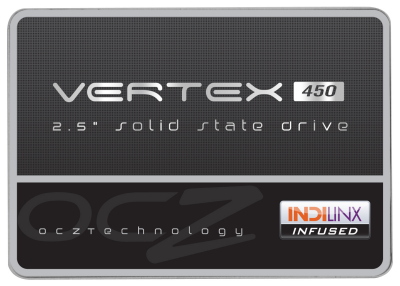- Details
- Flash Memory
Verbatim, a global pioneer of electronic data storage technology including optical media and flash memory, has expanded its popular and highly rated V3 Store’n’Go USB drive range with a product line offering faster connection and data transfer speeds. The V3 MAX delivers the fastest speed of any Verbatim USB drive.

With USB 3.0 connectivity that is backwards compatible with USB 2.0 ports, the V3 Max has a very impressive read speed of up to 175MB/sec and a write speed of up to 80MB/sec. It is available in storage capacities of 16GB, 32GB, 64GB and 128GB.
The V3 Max’s sleek appearance is boosted by a UV protective coating on its highly polished case to add further protection against scratches and marks from everyday wear and tear.
- Details
- Flash Memory
OCZ Technology Group, Inc., a leading provider of high-performance solid-state drives (SSDs) for computing devices and systems, today announced the release of the Vertex 450 SATA III SSD Series featuring the company’s proprietary Indilinx Barefoot 3 M10 Series controller. As part of the leading-edge Vertex series, Vertex 450 lives up to its name and bridges the gap between high performance and mainstream solid-state storage. With advanced storage performance, reliability, and quality, the Vertex 450 utilizes 20nm process geometry NAND flash to meet the needs of today’s high-end consumer and client applications.

“As one of the industry’s most highly awarded SSD Series to date, the Vertex name has become synonymous with the latest and greatest in flash-based storage providing an exceptional balance of performance and cost efficiency,” said Daryl Lang, Senior Vice President of Product Management for OCZ Technology. “The Vertex 450 marks the first time this popular OCZ series utilizes in-house ASIC technology delivering an even greater level of speed, reliability and value for our customers.”
- Details
- Flash Memory
SanDisk Corporation, a global leader in flash memory storage solutions, today announced it has begun customer sampling of flash memory products based on its industry-leading 1Ynm process technology, which represents its second generation 19 nanometer (nm) manufacturing technology.
SanDisk’s achievement of this breakthrough in semiconductor manufacturing takes its memory cell size from 19nm-by-26nm to 19nm-by-19.5nm, delivering a 25 percent reduction of the memory cell area and allowing SanDisk to continue leading the industry in building smaller, more powerful flash memory products.
SanDisk’s second-generation 19nm memory die uses the most sophisticated flash memory technology node to-date, including advanced process innovations and cell-design solutions. SanDisk's All-Bit-Line (ABL) architecture with proprietary programming algorithms and multi-level data storage management schemes help yield multi-level cell (MLC) NAND flash memory chips that do not sacrifice performance or reliability. In addition, SanDisk’s three bits per cell X3 technology, implemented in the second-generation 19nm node will deliver the lowest-cost flash solutions to address multiple growing end-markets for flash memory.
- Details
- Flash Memory
 Innodisk, a designer and manufacturer of SSDs for commercial and industrial applications, announces a release of the industrial-embedded industry's first SATA device in accordance to SATA µSSD standards – nanoSSD.
Innodisk, a designer and manufacturer of SSDs for commercial and industrial applications, announces a release of the industrial-embedded industry's first SATA device in accordance to SATA µSSD standards – nanoSSD.
Through the integration of a control chip, flash memory and peripheral power components into a single ball grid array (BGA) package, Innodisk has managed to reduce the size of the nanoSSD to approximately 1% the size of a 2.5” SSD. With dimensions of only 16 x 20 x 2 mm (WxLxH), a weight of only 1.5g, SATA III support, capacities ranging from 4 to 64 GB and both x86 and ARM compatibility, nanoSSD can be incorporated into a wide variety of applications where a small form-factor and high transfer rates are important, including industrial mobile devices, embedded systems, tablets, high-end smart phones and Ultrabooks.
Innodisk's nanoSSD not only offers the advantage of an incredibly small form factor, as a result of the integration of DRAM into a BGA, this product also features high read/write speeds of 480/175 MB/s, respectively. Whether for purposes of system booting, data storage, or data cache backup, nanoSSD can significantly improve overall system performance.
- Details
- Flash Memory
Toshiba Corporation and Toshiba America Electronic Components, Inc., (TAEC), a committed leader that collaborates with technology companies to create breakthrough designs, today announced that the company has developed second generation 19 nanometer process technology that it will apply to mass production of 2-bit-per-cell 64 gigabit NAND memory chips later this month.

Toshiba has used the new generation technology to develop the world's smallest 2-bit –per-cell 64 gigabit NAND memory chips, with an area of only 94 square millimeters. Using a unique high speed writing method, the next generation chips can achieve a write speed of up to 25 megabytes a second - the world's fastest class in 2-bit-per-cell chips.
Toshiba is also developing 3-bit-per-cell chips by using this process technology and aims to start mass production in the second quarter of this fiscal year. The company will initially introduce 3-bit, multi-level-cell products for smartphones and tablets by developing a controller compatible with eMMC, and will subsequently extend application to notebook PCs by developing a controller compliant with solid state drives (SSD).

